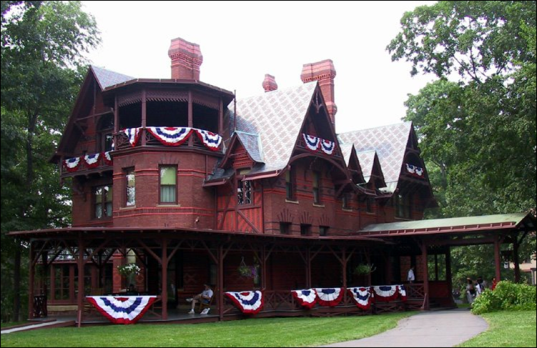By Cecilia Gigliotti
Writing Apprentice
Twain Studios
Do you speak American?
Mark Twain did. In fact, he is credited with pioneering the presentation of a distinctly American language as literature.
At the Mark Twain House & Museum in Hartford, Patti Philippon, chief curator, and Steve Courtney, publicist and author, had much to say about the forward-thinking 19th-century literary superstar. According to Philippon, Twain’s use of the vernacular – “slangs and colloquialisms” peculiar to certain geographical regions and races – is what makes books like Adventures of Huckleberry Finn stand out.
“It’s putting into words how people from that era sounded,” Philippon said.
Of course, oftentimes people didn’t sound so nice. Huckleberry Finn is defined today by the censorship and controversy surrounding Twain’s extensive use of the racist word “nigger.”
At New Britain High School a few years ago, a teacher in an American Lit class began to teach the novel – but not before closing the door. She introduced the book in hushed tones and told students not to mention it if they ran across the principal. She never said why.
Today, teachers across the state and the nation are working to combat this sensitivity.
Prof. Kerry Driscoll, who teaches English at the University of St. Joseph, is a longtime Twain enthusiast. She taught a summer class on Huckleberry Finn at the Twain House, where she has lectured a number of times.

Prof. Kerry Driscoll
In her experience teaching the book, two major dialectical barriers have stood in Driscoll’s way.
“At the level of comprehension,” she said, “It’s hard for students to understand.”
Sometimes, it helps students to hear the language rather than read it.
“What I recommend is that if there’s a word or sentence that you don’t understand, say the sentence out loud,” Driscoll explained. For instance, when the character Jim says “gwine,” what could g-w-i-n-e possibly mean?
“Sound it out,” Driscoll said, and the reader realizes that Jim is saying ‘going to.’
The accuracy of Twain’s characterization through dialect is astounding. Driscoll often asks her students’ opinions on why Twain includes, before the first chapter, a list of the seven dialects used throughout, such as ‘rural Pike County.’
“This is a realist book,” Driscoll said.
In using local dialects, Twain is holding a mirror to the lifestyle of those regions.
The other obstacle in Twain’s use of dialect is harder to conquer. The racial slur, Driscoll said, is what “makes the book so controversial.”
But she said it is key to understanding the “evolution of [Twain’s] own racial attitudes” and those of the times.
A recent edition of Huckleberry Finn in which the word ‘nigger’ is replaced with the word ‘slave’ is “an appalling decision,” Driscoll said. “That’s not the book Mark Twain wrote.”
As a teacher, she said, it is her responsibility to use the word in class discussion and stay true to Twain’s motives.
“The word appears 219 times in the book for a reason,” she said. “I’m going to read what Mark Twain wrote. It’s deliberately ugly, and I want students to hear it.”
Her determination has occasionally come at a cost. A student once complained that she was a racist teacher forcing the class to read a racist book.
But Driscoll has no intention of abandoning her approach.
“There’s no magic cure or fix,” she said, adding that the best teachers can give their students is “background preparation” – the word’s historical context and the obvious differences in tolerance of the word between the 1880s and now. Still, this is sometimes not enough to alleviate the soreness.
There’s been soreness for a while, and for a number of reasons. Since its publication, school districts and libraries in 28 states have banned the book.
But in 1885, public outrage stemmed from the opinion that Huck was not a proper role model for children. People were taken aback at Huck, the “irreverent” narrator, said Driscoll.
Driscoll described Huck as a “white-trash kid [allowed to] tell his own story on his own terms.”
In a pivotal scene, Huck decides to protect his friend Jim, a runaway slave, despite childhood teachings that the act would condemn him for eternity.
“All right, I’ll go to hell,” the boy resolves.
Huck was “a bad boy,” said Philippon, and Twain’s adult readers had a problem with that.
Driscoll pointed out the irony that while the objection in 1885 was not to the language used but to Huck’s offensive behavior, it has only been since the New York City school board banned it in 1957 that Huck’s character is celebrated and the language is found offensive.
The civil rights movement of the ‘60s, Courtney said, was a turning point for the racial slur. That was when it evolved into “a fighting word,” he said.
But Driscoll holds fast to her image of Twain as a “careful wordsmith.” Whatever words he chose, he wanted, she said.
In an 1888 letter, Twain wrote, “The difference between the almost right word and the right word is really a large matter – it’s the difference between the lightning bug and the lightning.”
Lightning can be both amazing and frightening to behold. It is an energetic force capable of destruction, but it plays a necessary role in the ecological cycle, and nature certainly would not be complete without it.
Using his charged language, Mark Twain infused our literature with a little more lightning, a spark that is uniquely American.
Posted in
Uncategorized and tagged
Adventures of Huckleberry Finn,
arts,
Cecilia Gigliotti,
Greater Hartford Arts Council,
Hartford,
Huck,
Huckleberry Finn,
Kerry Driscoll,
Mark Twain,
New Britain High School,
St. Joseph University,
Twain,
Twain Studios,
Write to the Point!,
Writing |






